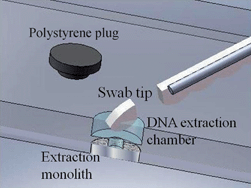Development of a real-world direct interface for integrated DNA extraction and amplification in a microfluidic device
Abstract
Integrated DNA

* Corresponding authors
a
Department of Chemistry, University of Hull, Cottingham Road, Hull, UK
E-mail:
s.j.haswell@hull.ac.uk
Fax: +44 (0)1482 466410
Tel: +44 (0)1482 465475
b Department of Biological Sciences, University of Hull, Cottingham Road, Hull, UK
c Centre for Biomedical Research, University of Hull, Cottingham Road, Hull, UK
Integrated DNA

 Please wait while we load your content...
Something went wrong. Try again?
Please wait while we load your content...
Something went wrong. Try again?
K. J. Shaw, D. A. Joyce, P. T. Docker, C. E. Dyer, G. M. Greenway, J. Greenman and S. J. Haswell, Lab Chip, 2011, 11, 443 DOI: 10.1039/C0LC00346H
To request permission to reproduce material from this article, please go to the Copyright Clearance Center request page.
If you are an author contributing to an RSC publication, you do not need to request permission provided correct acknowledgement is given.
If you are the author of this article, you do not need to request permission to reproduce figures and diagrams provided correct acknowledgement is given. If you want to reproduce the whole article in a third-party publication (excluding your thesis/dissertation for which permission is not required) please go to the Copyright Clearance Center request page.
Read more about how to correctly acknowledge RSC content.
 Fetching data from CrossRef.
Fetching data from CrossRef.
This may take some time to load.
Loading related content
